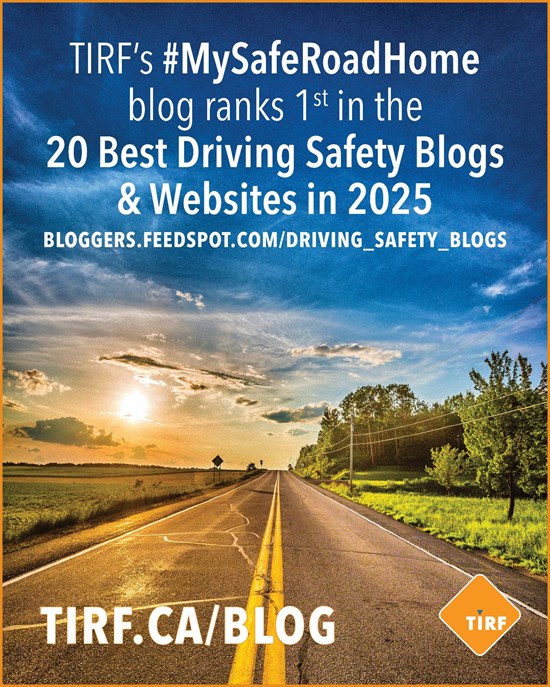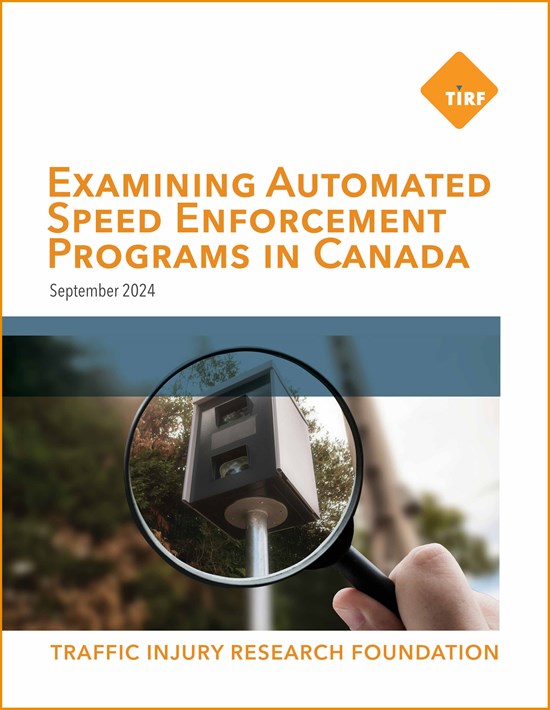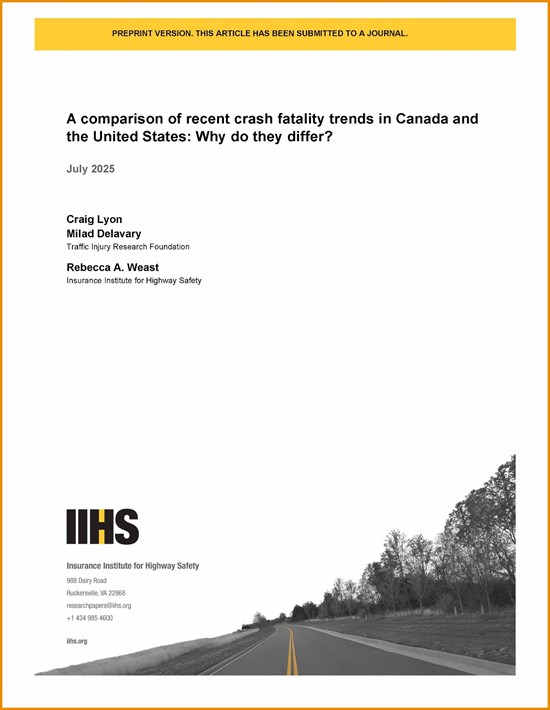Automated speed enforcement has resurfaced as a national flashpoint as some jurisdictions expand programs while others dismantle them or raise speed limits.
TIRF is weighing in ahead of the World Day of Remembrance for Road Traffic Victims to provide clarity based on more than sixty years of research on speed and safety.
Speed contributes to more than 400 deaths in Canada each year. Clear understanding of automated speed enforcement is urgently needed because the current debate has significant consequences for community safety.
Proponents and opponents are often arguing two different issues. Supporters focus on evidence of reduced speeds, collisions and injuries, while critics focus on implementation shortcomings, including site selection, privacy, ticket processes and revenue use.
Key myths require attention. These include beliefs that skilled drivers can offset risk, that everyone speeds, and that higher limits make roads safer. Evidence in Canada and internationally shows these perceptions are false and that higher speeds consistently result in more road deaths.
If speed cameras are rejected, alternative solutions to address speed-related deaths are likely to be equally or more controversial.
Ottawa, Ontario--(Newsfile Corp. - November 14, 2025) - Automated speed enforcement has been a source of controversy for more than four decades with ardent advocates alternately defending or disparaging this tool. This issue surged to the forefront in recent years as more jurisdictions have moved to either implement automated speed enforcement programs, or more recently to eliminate them, with some going a step further to raise speed limits. As both automated enforcement enthusiasts and their opponents trade arguments, it raises the question Are they even arguing about the same thing?
As this controversy reaches a peak, the Traffic Injury Research Foundation (TIRF), an independent, charitable, road safety research institute, has opted to weigh in on this issue. With the World Day of Remembrance for Road Traffic Victims on the horizon, TIRF's goal is to share more than six decades of experience examining speed-related issues and interventions to bring clarity and expertise to inform discussions about automated speed enforcement.
The sheer number of preventable deaths worldwide prompted the need for the World Day of Remembrance for Road Traffic Victims, launched in 1993 and later adopted by the United Nations General Assembly in 2005. This day honours victims and their families and is a call-to-action directly reinforcing the goals of the Decade of Action for Road Safety, originating in 2011 and currently the driving force behind the worldwide movement to reduce speeds everywhere.
In light of the high-profile debate taking place in Canada about speeding, speed limits and speed cameras, it's timely to address the automated speed enforcement issue as we remember the victims of road crashes.
"This debate is not new, but the stakes are incredibly high. More than 400 Canadians are killed each year in preventable, speed-related crashes; that's one in four road deaths. It's time to separate fact from opinion," said Robyn Robertson, TIRF's President & CEO. "Clarity about automated speed enforcement is essential so Canadians understand what is being argued for and against, and where it leads. The outcome of this debate has profound implications for the safety of communities and road users across the country."
According to TIRF, the historical arguments put forward on both sides over the years are not so different from those reappearing today in policy discussions, media reporting, articles and dueling comment sections. The discourse suggests proponents and naysayers are not having the same argument but are in fact debating two very different issues.
"Proponents of automated speed enforcement are generally arguing for their use with evidence of program effectiveness in achieving reductions in speed, collisions, and more importantly, injuries and deaths," said Robertson. "In sharp contrast, naysayers are often arguing against programs, citing limitations of implementation strategies, notably camera locations, the processes to review and validate tickets, privacy issues, the use of program revenues, and overall program transparency. On this basis, they question whether tickets are fair and if they change behaviour."
A deeper dive into these issues suggests both sides have a point. TIRF's Automated Speed Enforcement (ASE) report funded by the Insurance Institute for Highway Safety (IIHS) showed these programs decreased crashes between 9% and 18% for all crash types and decreased injury crashes 51%. Among 14% of respondents who had received a ticket, most (79%) said it changed their behaviour, including 65% who said they reduced speed in most driving situations.
It further showed communities with ASE programs had high levels of support. A City of Ottawa survey of residents revealed strong support for ASE which varied by location type, including:
- 87% near schools
- 85% near playgrounds
- 77% near hospitals
- 76% near parks & seniors' residences
- 65% on any road where there is speeding
On the other hand, the most common objection to these programs has been a lack of transparency in program implementation. Questions about site selection, how cameras work, the use of signage to warn drivers, who validates tickets and how, at what speed tickets are issued, fine amounts and how revenues are used, are at the forefront of concerns. They also challenge whether speed cameras change behaviour, often based on personal or anecdotal experiences.
In truth, the facts suggest advocates on both sides of the issue are not wrong in principle. Yes, there is irrefutable evidence of effectiveness. But at the same time, as evidenced in TIRF's ASE report, there is also recognition that the transparency of program implementation has been inconsistent, and at times sadly lacking, leading to frustration and opposition. While communities aim to consult and raise awareness about these programs, messages are not always received, suggesting different communication strategies and tools are required.
"What is equally obvious from this ongoing debate is that research and data are not necessarily the most compelling evidence to sway public opinion," said Ward Vanlaar, TIRF COO. "Similar to legislative and policy discussions, while it's a critical piece of the puzzle, decision-makers may not attribute research more weight than other forms of evidence."
"Perhaps what's needed to move towards resolution is to reframe the discussion to speak to the individual experiences of drivers and challenge the most common misperceptions using scenarios that are personally relevant," said Karen Bowman, TIRF Director, Communications & Programs. "We consistently use this style in our MySafeRoadHome blog series which has become the top ranked Driving Safety Blogs & Websites in 2025 according to FeedSpot."
Some of the most problematic misperceptions which must be addressed are below.
- Drivers can speed because they are above average, in control or have never crashed. FALSE. Even the most skilled, above average drivers can still be crash-involved because they can't predict when an unexpected event will happen. Every Canadian driver has been cut off or had a driver stop suddenly, had a dump truck or a crash ahead halt traffic in its tracks, or seen a dog or a deer run into the road. Cyclists swerving to avoid a sewer or a parked car; or drivers changing lanes without signaling or spontaneously turning at the last moment are almost routine. Near misses are more common than drivers think.
"Drivers who have not been crash-involved (yet) may feel invincible because they can take a corner faster than indicated or speed on a straight stretch. But they are not Max Verstappen. They possess neither the training nor the control, particularly when the unexpected happens on the road," said Vanlaar. "That feeling of control which leads them to believe they are above average is an illusion. Control exists only when the actions of every other road user can be accurately predicted and everyone obeys all rules every moment. Rules create predictability so road users can consistently anticipate the actions of others, but humans make errors which can result in crashes. Drivers everywhere bear witness to this every day."
"Drivers who believe they are above average or in control are confusing better road design and safer vehicle design with their driving competence. The tremendous progress achieved with crash reduction is more due to building forgiving roads and vehicles designed to mitigate crashes. A better understanding of risk has also educated many drivers to make safer choices," said Robertson. "But speeders and other risk-takers have misinterpreted these outcomes, believing an illusion that they can handle unexpected events, even when travelling at high speeds despite having less time and distance to avoid a crash."
- Everyone speeds. FALSE. Most drivers don't habitually speed. If they did, no progress would be reported, and deaths would rise exponentially. A 2023 survey of Canadian drivers conducted by TIRF showed 11% of drivers admitted to driving more than 30 km/h over the limit. Roughly seven out of 10 Canadians admitted speeding by 20 to 30 km/h over the limit on highways at least occasionally. This doesn't mean drivers speed all the time; but that they may do it in some circumstances for a variety of reasons such as passing a large vehicle, avoiding a hoard of drivers travelling too close together, or completing a pass before a lane ends. These instances still create risk and are unsafe, but it's not the same as habitual speeding.
"Every speeder has encountered drivers sticking to the limit on their daily commute. They speed past them to get to the next red light, almost rear-end drivers who stop on a yellow, or tailgate them to get out of the left lane because they are impatient to sit behind the car in front of them," said Bowman. "These are the drivers they pass on the right or cut off while erratically changing lanes to find a faster one, which doesn't exist."
"More concerning, the survey showed a majority (91%) of drivers reported at least occasionally seeing other drivers speeding, more than one in ten (13%) reported having a near-crash experience due to speeding in the previous 3 months, and 2% reported having a speeding-related crash in the previous 3 months," said Steve Brown, Research Associate & Data Collection at TIRF. "The current prevalence of speeding has quite likely been negatively impacted by diminished traffic enforcement during the pandemic and declining capacity for traffic enforcement following it."
While crashes are a well-recognized consequence of speeding, what may surprise many Canadians is that the frustration of commuters everywhere, the dreaded traffic jam, is often a result of inconsistent speed. When traffic slows, speeding drivers who persist in racing up to the car crawling ahead, only to hit their brakes, or opt to change lanes repeatedly, are in fact the problem grinding everyone to a halt.
Speed limits create consistency and are set based on roadway design. While some drivers may feel comfortable exceeding the speed limit, more drivers feel comfortable adhering to it. More importantly, speeders have no authority to unilaterally select their preferred speed and act as a Pace Car, demanding everyone else follow. The reigning authority on highways are provincial highway traffic acts which grant enforcement powers to police and impose fixed penalties for speeding.
- Increasing speed limits makes roads safer. FALSE. Countless experiments around the world have investigated the effects of increased speed limits. Every one of them ended with more deaths. That's fact. Perhaps the most notable example that advocates espouse is the infamous Autobahn, but a closer look at the facts paints a different picture. Some salient caveats to the Autobahn experience are that much of it has fixed speed limits; the absence of limits applies only to very specific road segments. Automated speed enforcement has also long been prevalent across many German roadways. What may be less well known is that 20 years ago a European Transport Safety Council (ETSC) report showed that among 645 road deaths in Germany, two in three deaths (67%) occurred on stretches without limits while 33% were on stretches with a permanent limit, clearly illustrating the risks.
While the relationship between speed and crashes has been well-established for decades, a few jurisdictions have still opted to increase limits as a policy position. Even here in Canada, British Columbia made this move in 2014. It surprised no one as speed-related deaths doubled when limits increased to 120 km/h from 100 km/h. More than half of highway segments showed safety deterioration and their limits were subsequently rolled back, or additional safety measures were added. What is noteworthy is that the proposed 15-20 km/h increase in speed, which has been championed by advocates, and more recently in editorials, as perfectly safe, is the same 15-20 km/h increase in speed which results in more deaths, shown time and again.
Taking a broader look at fatality trends across countries, a recent TIRF article co-authored with IIHS that compared road fatality trends between Canada and the U.S. revealed Canada has achieved much more significant declines. This held true even during the pandemic whereas the U.S. experienced a sharp reversal with substantial increases in fatalities.
"The report revealed drivers in the U.S. self-reported higher rates of risk-taking than Canadian drivers with respect to many risky behaviours, including often driving over the speed limit (29.4% vs. 25.3%). Road safety-related laws and enforcement also tended to be stricter or more widespread or both in Canada. A population-weighted measure capturing if ASE was permitted showed twice as many Canadians live in jurisdictions where it is allowed than in the U.S.," said Craig Lyon, Director, Road Safety Engineering at TIRF and lead author on the article. "Moreover, a population-weighted measure of the maximum posted speed limit in provinces and states showed Canada was lower at 105 km/h compared to 113 km/h in the U.S. It suggests the implementation of different countermeasures in Canada, some of which have not been adopted in the U.S. or have been adopted to a lesser extent, have influenced these outcomes."
Solutions to manage speed simply must be found because the research is unequivocal. Speed kills. Faster speeds mean drivers have neither time nor the distance to safely avoid collisions, resulting in deaths and more severe injuries which are represented in statistics. These numbers are family, neighbours, colleagues, and friends. While they may not be yours, they are definitely someone's. The pain is also etched into the faces of countless first responders attending crash scenes; desperately hoping to rescue a victim, still breathing; not recover a body, still warm.
"The reality is if enthusiasts and opponents cannot find a way forward with respect to the use and implementation of automated speed enforcement, it's important to understand where this path takes us," said Robertson. "Canadians have three choices. The first two involve many more police actively enforcing speed laws and more infrastructure solutions, both of which come with enormous costs to communities. The third option involves embracing vehicle technology which opponents will like even less than automated speed enforcement."
The option of employing more officers on the road to enforce speed laws comes with two significant costs; one financial and one personal. The former involves local taxpayer dollars to fund increases in police manpower to prevent fatalities from skyrocketing. The latter is the cost to the families of police officers who will put their lives on the line every day. Policing roadways in a vehicle or standing at the roadside of traffic moving at speed are among the greatest risks police officers face.
The option of infrastructure solutions in the form of traffic calming measures requires an inordinate investment of local tax dollars (borne by all taxpayers and not just offenders); even assuming the space needed at problem locations is available. These include raised speed bumps/humps, speed cushions, traffic circles, curb extensions, lane reductions and narrowing, adding visual cues like trees and on-street parking, as well as more speed signage including the use of driver feedback signs. While these tools offer proven benefits in residential and school zones, their application on high-speed arterial roads warrants careful consideration. Some measures can inadvertently slow traffic for everyone, including vital emergency services such as fire trucks, ambulances, and police vehicles, potentially affecting response times during critical moments. Even in a perfect world, assuming the geographic design of communities would accommodate space for such changes, the reality is a number of these solutions have already been pursued. While they have had benefits, scale is the problem with costs borne by communities, to say nothing of the length of time it takes to implement them. Moreover, persistent speeders don't always respond by slowing down.
It is this persistence that has necessitated communities to embrace automated speed enforcement to prevent road deaths and life-altering injuries. If neither enforcement nor traffic calming measures prompt drivers to abide by speed limits and automated speed enforcement is rejected, the only real question is, What tools will governments rely on to change behaviour?
The next iteration of speed reduction countermeasures is mandating vehicle technology in the form of Intelligent Speed Adaptation (ISA). This means governments on behalf of all drivers will place their trust in vehicles to make the smart choice, because they no longer have confidence in drivers who speed to do so. Several forms of this technology are already available, and the European Union has moved to adopt some variations of it. While there is still more research needed, policy questions to answer, and political resistance to overcome, this technology is here to stay. The level of adoption and type of ISA ultimately implemented will most certainly be reflective of the behaviours of drivers who continue to speed and place other road users in harm's way.
"The bottom line is that a wholesale rejection of automated speed enforcement combined with increasing speed-related fatalities and serious injuries will undoubtedly accelerate the adoption of ISA," said Robertson. "While it's likely not an outcome anticipated by speeders, it will most certainly be their behaviour that moves us towards this reality… faster."
If there is one thing Canadians should take away from this debate, it's this. The side of the fence we come down on will most certainly have immense significance for the future safety of your communities, families, friends and colleagues for generations.
Related resources:
If supporters of automated speed enforcement are looking for a no-holds-barred, gloves-off perspective based on research into automated speed enforcement that can be used to challenge ingrained misperceptions of the speeding problem that are cited ad nauseum, you'll find it here: Is the problem automated speed enforcement? Or is it just you? https://tirf.ca/blog/automated-speed-enforcement
At the same time, if opponents are looking for research that supports stronger and better designed implementation of automated speed enforcement, they can find it here: Examining Automated Speed Enforcement Programs in Canada https://tirf.ca/projects/automated-speed-enforcement/
Comparison of crash fatality trends in Canada and the United States https://tirf.ca/projects/comparison-crash-fatality-trends-canada-usa/
Getting away with speeding: Is the cost worth it? https://tirf.ca/blog/speeding-is-the-cost-worth-it/
Anatomy of a Road Crash https://tirf.ca/diad/e-hub/education-tools-resources/first-responders
The Impact of Road Crashes on First Responders & Communities: Post-Traumatic Stress Disorder & Critical Incident Stress https://tirf.ca/diad/e-hub/education-tools-resources/first-responders
World Day of Remembrance for Road Traffic Victims https://worlddayofremembrance.org/
Decade of Action for Road Safety 2011-2020 & 2021-2030 https://unece.org/second-decade-action

20 Best Driving Safety Blogs & Websites in 2025
To view an enhanced version of this graphic, please visit:
https://images.newsfilecorp.com/files/10180/274538_41d537f7a481d8fd_001full.jpg

Examining Automated Speed Enforcement Programs in Canada
To view an enhanced version of this graphic, please visit:
https://images.newsfilecorp.com/files/10180/274538_41d537f7a481d8fd_002full.jpg

Crash fatality trends in Canada and the United States
To view an enhanced version of this graphic, please visit:
https://images.newsfilecorp.com/files/10180/274538_41d537f7a481d8fd_003full.jpg
About TIRF Canada:
The vision of the Traffic Injury Research Foundation (TIRF) is to ensure people using roads make it home safely every day by eliminating road deaths, serious injuries and their social costs. TIRF's mission is to be the knowledge source for safe road users and a world leader in research, program and policy development, evaluation, and knowledge transfer. TIRF is a registered charity and depends on grants, awards, and donations to provide services for the public. Visit www.tirf.ca or find all TIRF websites, blog and social media at https://linktr.ee/tirfcanada.
- 30 -
For more information or to arrange an interview, contact:
Karen Bowman
Director, Communications & Programs
Traffic Injury Research Foundation
613 238-5235 (office) | 1 877 238-5235 (toll-free) | karenb@tirf.ca

To view the source version of this press release, please visit https://www.newsfilecorp.com/release/274538
SOURCE: Traffic Injury Research Foundation